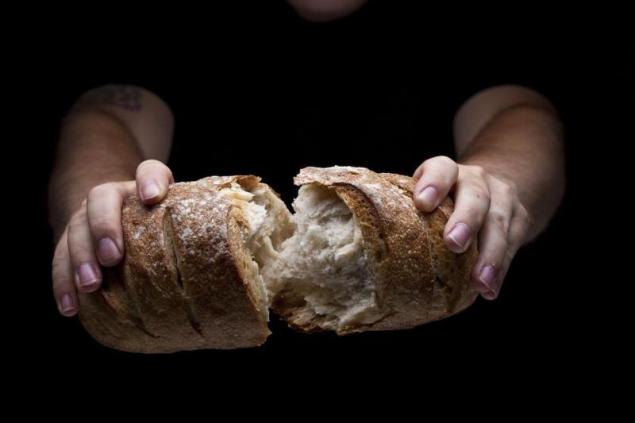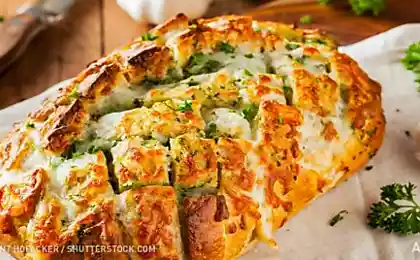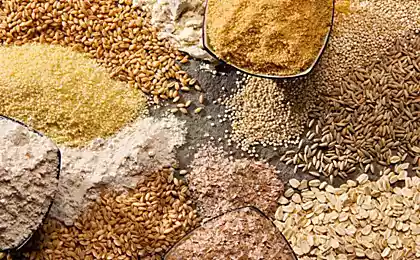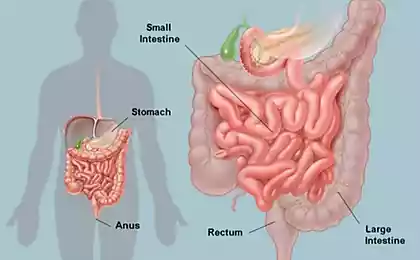333
The phenomenon of the influence of gluten – the effect of Pandora’s Box
Essay on bread
Medical certificate:Gluten is contained in the product, which is formed from the flour of grains after the extraction of starch from it. This residual product is a mixture of many proteins that vary in their solubility and ability to extract. In different cereals, this component has a different name: in wheat - gluten (gliadin), in oats - avenin, in barley - gordein, in rye - sekalinin.
God and the devil, light and darkness, life and death, bread and hunger are classic examples of the law of unity and the struggle of opposites, one of the most important laws of the universe.
I dedicate this essay to bread, the symbol of prosperity, namely, its main component – wheat. Evil, giving strength and life, but, as it turned out today, gradually bearing disease and premature death. The effect of Pandora’s Box is the effect of eating a slice of bread.

“A great scientific idea is seldom introduced by the gradual persuasion and conversion of its opponents. The reality is that the opponents gradually die out and the growing generation is absorbed from the beginning with a new idea.” ©Max Planck
Sometime in the late 70s, the newspaper Komsomolskaya Pravda published an article by V. Peskov about the problems arising in hunting farms for the party elite. He described in this article a case of unexpected epizootics among moose in one such farm early in summer. Moose died far from units, moreover, they were not exhausted (all the same special feeding all winter and spring, so that the animals were nourished, when the party bosses will take them on the fly!). Studies on the alleged sabotage with the planting of poison or some unknown ailment also gave no result. That's when I realized that maybe it's just the feeding fault. For her that winter often used not vegetable food in the form of hay, and bread!
And although it was initially unclear how bread (a holy concept!) was responsible for the death of so many animals, given the importance of the problem, it was figured out!
The fact is that the diet of moose includes all mushrooms. In winter, there are no mushrooms in the forest, except, of course, oysters and other tinders growing on rotting wood. This group of mushrooms is never poisonous to anyone. By the way, China exports hundreds of tons of mushrooms of this particular group, without fear of complaints about the poisoning. They are more or less useful and more or less delicious.
So, while it was winter and spring, the moose calmly ate bread from the feeders and were happy. But as soon as the warm days went and mushrooms climbed from the ground, the animals immediately diversified their diet with all mushrooms, including pale toadstools. They had not been fed bread for more than a month. And they began to die one by one.
After extensive research, it was discoveredphenomenon of the influence of gluten on the mucous membrane of the small intestine animals that made it permeable to poisons of a protein nature with sufficiently large sizes of molecules, which include phallatoxins and amatoxins contained in a pale toadstool. And it turned out that the effect lasts up to two or more months after the last consumption of bread.
Unfortunately, conclusions were made only for the rules of feeding moose in hunting farms. Further, the scientific thought did not go. As a novice nutritionist, this material prompted me to further reflection and search for new methods in the treatment of sick people.
The essay offered to your attention is not the result of strict scientific research, claiming the absolute reliability of the conclusions. This is just an attempt to understand and systematize your experience accumulated over 35 years of extensive medical practice.
First, of course, we will look at the problem from a well-known medical position. An intolerance to gluten-containing products in humans is called celiac disease. The problem is complex. It has been studied for decades.
Note: The gluten content of wheat ranges from 7 to 15 percent by weight, reaching 20 percent or more in hard, highly valued varieties. This figure is slightly higher than 1%. Rye and barley in the quantitative content of gluten occupy an intermediate position between oats and wheat.
The problem was first described in 1888 by S. Gee, who noted three main symptoms of the disease: chronic diarrhea, progressive weight loss and a large flabby stomach. For a long time, the cause of the disease remained unknown. It wasn’t until 1950 that W.K. Dike and colleagues established that the external factor causing celiac disease was the protein gluten of wheat, rye, oats, and barley.
To date, various terms are used to refer to celiac disease, including nontropical sprue (from the Dutch. sprue - foam, since the patient's stool sometimes resembles foam), gluten enteropathy, Guy-Herter-Heibner disease.
Development mechanism
The relationship of damage to the superficial villous epithelium of the mucous membrane of the small intestine with the development of celiac disease has been established for a long time, however, the final mechanism of the development of the disease has not been clarified. According to one theory, in celiac disease, there is a deficiency of a certain intestinal enzyme that normally breaks down gluten (enzymatic theory). This leads to the accumulation of unsplit products in the lumen of the intestine and toxic reactions on the surface of the mucous membrane. But to date, this enzyme has not been isolated.
According to the immune-allergic theory, the change in the intestinal wall occurs due to a number of immunological reactions that cause gluten exchange products. Proponents of the receptor theory believe that in celiac disease there is a congenital change in the sensitivity of epithelium cell receptors to gluten. According to the viral theory, a violation of gluten digestion and a change in the properties of the mucous membrane of the small intestine is due to the negative effect of viruses on cells. But a combination of these theories and features of the formation of the disease is also possible. Genetic factors are of great importance in the development of celiac disease. On average, 14% of parents of patients themselves suffer from this pathology in a latent form. Although the statement of this fact still does not give anything to understand the mechanism of the disease.
According to the clinical picture, it is sometimes very difficult to diagnose celiac disease, since the initial signs are similar to inflammatory diseases of the digestive organs in children. Serological diagnostics (by blood) is of great importance, the purpose of which is the early detection of specific antibodies of the IgM and IgA class.
These tests are called GSE (Gluten-sensitive enteropathy) tests. Endoscopy and biopsy of the small intestine mucosa are performed. Moreover, sometimes a biopsy of the intestinal mucosa is repeated after taking foods with gluten. For a differential diagnosis with other fermentopathies, load tests with D-xylose and gluten are prescribed. An additional method of examination can be a study of feces to assess the degree of steatorrhea (fat in feces), which allows you to differentiate the lesion of the pancreas Determination of carbohydrates in feces allows you to establish the severity of lactase deficiency. Unfortunately, there is currently no single sensitive and specific method for diagnosing celiac disease. In 1969, the European Society of Gastroenterologists and Nutritionists (ESPGAN) proposed the following criteria for celiac disease:
Persistent gliadin intolerance. In the active phase of the disease, atrophy of the mucosa of the small intestine develops. Against the background of a diet without gluten (gliadin), the mucous membrane is restored. Repeated administration of gliadin in nutrition leads to the development of atrophy of the mucous membrane of the small intestine ... Today, in addition to the diagnosis of celiac disease, there is a diagnosis: celiac disease syndrome. This condition is clinically similar to celiac disease, but develops due to any acute disease, stress. However, this condition disappears after the end of the provoking factor.
Based on the assumption that the above-mentioned moose from the hunting farm did not suffer from celiac disease a priori, I created my own diet in 1981, which excluded, among other things, gluten-containing foods for 3 months. It gave an amazing result in a variety of cases.
Putting patients with a variety of pathologies and complaints official diagnosis (more often as a concomitant): gluten enteropathy and transferring them to a gluten-free diet, I risked to be a white sheep, because without a biopsy of the mucosa of the small intestine and subsequent histological analysis, this diagnosis colleagues always strive to question. However, I used, often practiced in cases of suspected celiac disease, because of the difficulties in accurately identifying the disease, the method of treatment ex juvantibus, that is, if the result of treatment is not successful, the diagnosis is wrong.
Since it was usually not celiac disease, minor violations of the regimen such as eating prosphora crumbs in the church did not prevent the appearance of positive results. The results were not long in coming. At first, complaints about dyspeptic phenomena disappeared, and in the longer term (with strict adherence to the gluten-free regime) various, even unexpected positive phenomena appeared. As in many dermatological diseases, including psoriasis.
The exception was some cases of various allergies. I figured this out after 1985, when I got my hands on Lessof’s monograph, Clinical Responses to Food.
It turned out that gluten-like effect is given by the waste products of many worms. And, switching to a gluten-free regime, you should regularly engage in deworming. Maybe even preventively, because we are not aware of all worms.
As for the constant ingestion of small doses of gluten into our body, today I can say the following: there are already special tests for the quantitative content of gluten in certain products, medicines, etc. Minimum allowable amounts of gluten in the daily diet for patients even with celiac disease, and not only debatable forms of gluten enteropathy. All kinds of ways of getting gluten into products when they are falsified or reduced technological control are quite clear.
In addition, the majority of the population, it seems to me, suffers rather than celiac disease, and gluten enteropathy. What is the difference between these two diagnoses in my mind? In both cases, damage (permeability violation) of the mucous membrane of the small intestine occurs necessarily. And leads, after excessive intake of gluten-containing products, to various consequences that have only now begun to worry the medical community around the world (the wave of problems is growing catastrophically, and not everything can be attributed to the environment).
However, if in celiac disease the patient suffers from gluten poisoning directly, in the literal sense of the word, then in the case of gluten enteropathy (I emphasize, in my understanding) the matter does not go so far. The permeability of the intestinal mucosa increases, and the allergic-toxic reaction of cellular immunity / KI / to gluten is practically absent. Compensatory mechanisms work, which "sluggish" or even absent in patients with celiac disease. But the increased permeability of the intestinal wall remains!
Every year, in disparate publications of both scientific and medical news, more and more facts accumulate indicating a causal relationship between the consumption of wheat flour products and the appearance of skin diseases, mental disorders, autoimmune problems, osteoporosis, etc., etc.
By the way, in Italy, Australia, Germany and other countries for about 20 years, if I'm not mistaken, there are large companies with millions of turnover, producing all sorts of gluten-free products. Cookies, pasta, even gluten-free flour - instead of gluten, carob gum is added to it, which performs its gluing function, but does not damage the intestines.
This product is sold all over the world, in Ukraine, too. Moreover, these products are sold not only for patients with celiac disease, but also for supporters of just a healthy diet. I will not argue with the lawyers of wheat about the significant content of the products of it necessary to man vitamins of group B. To deny the obvious technological conveniences of the presence of gluten in baking and preparing products from wheat dough is generally stupid. But there is a lot of usefulness in the pale grebe! Oh, well cooked, and delicious. This is confirmed by numerous annual cases of poisoning among the population. However, since the connection of the toadstool with mortal danger has not only been proven, but also became a household name, purposefully wanting to taste it a little.
As for gluten-containing products, almost everyone eats them. And hundreds of years. India, China and Japan are a separate issue.
To understand the situation, I would draw a clear analogy: for hundreds of years, people looked at the sun and the horizon every day. And, by and large, everyone considered the Earth flat and the center of the universe. The sun is a sacred formation that revolves around the earth. Those who allowed themselves to doubt this, awaited the unenviable fate of Giordano Bruno.
But the 18th and then the 19th and 20th centuries came and those who persisted in this interpretation were laughed at. I think it will be the same with bread.
For various reasons, but certain steps are being taken. So far, as an incident on the scale of the whole state. On January 1, 2007, a new law on baby food came into force in Ukraine. On the territory of Ukraine, nutrient mixtures for newborns containing certain additives, including wheat flour, were banned for sale and use. Ukraine was the first and only country in the world that legally banned wheat flour in the diet of children. Since July 16, 2009, this law has been implemented. In fact, no- or low-gluten formulas were recommended for all newborn babies. Oatmeal was not prohibited. The innovation met with misunderstanding among the medical community and confusion among most of the population. Only those parents of newborn children who were aware that the consumption of wheat flour by healthy babies in the near future can lead them to allergies were happy. But the joy was short-lived. In March 2010, the new Ukrainian government repealed the law, citing the bureaucratic mistakes of the previous government. Bread is the head of everything. Well, you won't be violently nice. The time has not yet come for such revolutions.
And gluten. There is a state of Punjab in India. There, wheat gives up to 4 harvests per year. And, almost everything is exported for two reasons: firstly, it has a lot of protein (the same gluten) and it belongs to very valuable hard varieties, convenient for the production of all sorts of "kuciupelik", therefore, it is a good income for residents; secondly, the local indigenous population does not eat it, preferring rice. Of course, someone in India eats bread from gluten-containing cereals, and cakes are baked from them. But, by and large, this is the exception, not the rule.
I've never been to India. But, I suppose, again by analogy, to determine the temperature of the surface of the Sun, it is not necessary to fly there with a thermometer. I don’t think it’s necessary to hold a referendum in India, Japan or China to find out which crop the population prefers.
By the way, another interesting observation. Wheat has been known to people for several thousand years, the cereal was fruitful, convenient for storage, tasty. It was widely consumed in Europe. But, today for me, for example, it is striking that in those, well, very ancient times, in Egypt wheat bread (rather flatbread, and not bread buns in our understanding, because pastries from such flour practically did not keep germination!) was baked from flour, grinding sprouted and then dried wheat. Thus, drastically reducing, almost to zero, depending on the degree of germination, the amount of gluten in wheat grains. Egyptians were considered the healthiest in the ancient world.
In the Bible, in the Revelation of John the Theologian, there is a mention of the number of the Beast. It is something extremely terrible, dangerous, difficult to define, hostile to man. Moreover, this is something that poses a mortal danger to people.
If we proceed from our current knowledge about the dangers of consuming gluten-containing products and not be afraid of allegory, then the photo below may well be called the “face of the Beast”.
The history of mankind as we know it is filled with almost continuous wars and countless atrocities. According to recent data, bread eaten in Europe for thousands of years (!) can awaken not the best human qualities inherent in individual genes: cruelty, imbalance, unmotivated aggressiveness, vandalism.
And, although not on one gluten all this is mixed, yet there are numbers of ordinary, somatic and mental diseases that cause bread or extremely interfere with recovery from them. But bread is not a poison, either! The problem is so carefully disguised that the very concept of “bread” has become synonymous with a valuable, vital product.
Today, traditions and bakery companies stand on the side of bread to the death. This, of course, is a very serious, but insurmountable obstacle for a thinking person!
I'll do it again. In four types of cereals - wheat, rye, barley and oats contains in varying amounts such a component as gluten or gluten. “It is a mixture consisting of amino acids, glycopeptides, acid peptides, dialyzable and undialyzable peptides and enzymes with different properties, which are determined both by the main protein chain and the attached side chains of non-protein conjugates, and therefore different in physical and physical-chemical properties. Perhaps, therefore, it is not surprising that his identification has not yet been carried out / see the monograph under the editorial board. Lessofa, translation into Russian, "Medicine" Moscow, 1986 "Clinical reactions to food" /.
In this monograph there is a lot of interesting, and with thoughtful reading even unexpected for everyone interested not only in nutrition tactics, but also in strategy. In the 25 years since the publication of this book in Russian, I have not found any radical changes in the basis of published materials. Maybe he was looking badly...
According to my personal clinical observations, a single intake of several grams of gluten-containing product /subject to prior long-term absolute abstinence from gluten-containing products! / after a couple of hours sensitively increases the permeability of the small intestinal wall for large molecules of various components of putrefaction and fermentation in it, compared with the previous state. And this new state of the intestinal wall, slowly returning to the original boundaries, lasts about two months (!). Remember moose...
Accordingly, a significant proportion of the products of putrefaction and fermentation in the intestine enters the portal vein into the liver, creating an additional toxic load on this organ. An interesting effect of healing allergies - it definitely manifests itself two to two and a half months after the last eaten piece of gluten-containing product. (It is the removal after two or three months of this toxic load that can explain the miraculous clinical effect of switching to a rigid gluten-free diet for all kinds of allergies, hepatitis, gastrointestinal diseases, CNS, etc.). Parallel to this process, a number of large antigenic complexes, perhaps by persorption or passive penetration (and maybe something else?) slowly travels through the body, deposited in various parts of it, according to genetic features, the influence of various environmental factors. In general, the situation resembles a game of Russian roulette, with inevitable unpredictable damage, both functional and organic.
The list of diseases, the course of which is dependent on compliance / or non-compliance / gluten-free regime is really large. As quite unpleasant and at the same time frequent can lead very many types of allergies, hepatitis, osteoporosis, ending with fractures with fairly harmless falls, multiple sclerosis, depression, schizophrenia, various mental disorders, many skin diseases, autoimmune diabetes mellitus of the first type, many types of oncology. The list goes on for a long time. I would like to return to the prevention of this nightmare.
I believe that the combination of the following factors: proper and comfortable separate nutrition with the prevalence, if possible, of raw products, therapeutic and prophylactic starvation, rigid gluten-free regime, in combination with symptomatic pharmaceutical intervention and other known hygienic methods, allows you to really keep the internal environment of the body in a certain purity. It seems that this approach to health is most effective at this stage of development of our knowledge about the world.
Practice allows you to divide the methods used in the pursuit of a healthy lifestyle into two categories: tactical and strategic. In my opinion, the strategic methods should be attributed in order of priority: gluten-free regime, fasting, raw food. Next are: the lack of refined foods, “gentle” vegetarianism (excluding not all products of animal origin, but only slaughter!), a competent schedule of taking groups of products during the day (not to be confused with separate nutrition, because separate nutrition with a gluten-free regime does not look so mandatory, because the liver is sensitively facilitated!).
By the way, the striking effect of fasting, carried out in a variety of both therapeutic and surgical diseases, in my opinion, is explained both by stimulating the proliferation of stem cells diffusely dispersed in all tissues, and by moving to the exit of the already mentioned large antigenic complexes deposited in various parts of the body. The so-called naturopaths call them “slags” or “dirty.”
What are refined products? What is raw food?
Refined productsThese are products artificially purified from most natural ingredients in favor of one that, for some reason, at this stage of scientific and consumer concepts is considered to be the main, most important component of this food product. For example: refining raw sugar to a snow-white state of crystalline sucrose, when even rats (!) avoid consuming this wonder of the food industry! And, artificially created, the deficit in the refined product of the components necessary for us is compensated by special drugs, which, by the way, is very difficult and not always available.
Another example is refined vegetable oil. Of course, it can be stored for years (in case of any force majeure circumstances) in contrast to the usual unrefined, but it is devoid of many important elements for us. However, there are sometimes trace amounts of gasoline used to extract fat from sunflower seeds during the refining process.
Raw eating- it is a diet exclusively raw fruits, vegetables and nuts. The method is well illustrated in the books Shatalova G., Chuprun A. and others. So I don't want to repeat myself.
And the question of what else contains gluten, I will add a little new to the material already described. In whole grains of corn, gluten is contained in seed germs, but since, in the process of producing corn cereals and flour, grain germs are separated due to technological features, then corn flour and cereals, obtained not by artisanal, but by quite industrial means, practically do not contain gluten.
More accurate, quantitative data on corn germs in recent years, unfortunately, I did not come across. By the way, it is useful to know that before the arrival of Europeans on the American continent, the Maya and Aztec peoples strictly adhered to the ban on the consumption of corn grains of this year’s harvest. Corn cobs on the lost technology were processed, overflowed and aged in special storages for several years. Perhaps this was due to the decrease in gluten in the embryos? Unfortunately, it seems that this mystery has sunk into oblivion.
I must say that the list of gluten-containing products has recently expanded significantly, since wheat flour, and often powdered pure gluten, began to be added to many types of sausages, cheese (!), ketchup, various sauces, confectionery, etc. In which, according to the GOST, there should be no torment!
How much gluten is in a normal diet and how much is needed to cause damage to celiac disease?
A normal diet contains about 10-40 grams of gluten per day. This figure is based on the amount of gluten in an average piece of white bread, which contains 4-8 grams of gluten (10% gluten of total weight), and the amount of gluten in a serving of pasta, which is usually 4-6 grams of gluten (11% of total weight). According to Italian researchers, the minimum amount of gluten, which leads to damage to the small intestine, in patients with celiac disease is 50 milligrams per day. This is about the amount of gluten contained in 1/100 of a piece of bread! The biopsy in this study shows an increase in the number of interepithelial lymphocytes — one of the earliest symptoms of the lesion. Changes were recorded in each of the 10 patients (children) after 28 days.
Original source:
www.celiac.com/st_main.html?p_catid=2&sid=91hH9H0-nJ@F6hn27104075134.2f
By the way, people who don't suffer celiacThe damaging amount of gluten is the same! But they have compensatory mechanisms. And a quick, imminent disaster bypasses them. Trouble accumulates gradually and keeps you waiting for a long time. However, sooner or later (it depends on the genetics of a person, he eats a little or a lot of gluten-containing products, how and with what he eats bread, “what is written in the family”, etc.) problems appear.
Sensitivity and specificity of determining blood levels of various antibodies in celiac disease (in adults):
Antibodies
Sensitivity
Specificity
EMA
97%
98%
IgG AGA
88%
92%
IgA AGA
Source: doctorartemov.com/content/esse-o-khlebe
Medical certificate:Gluten is contained in the product, which is formed from the flour of grains after the extraction of starch from it. This residual product is a mixture of many proteins that vary in their solubility and ability to extract. In different cereals, this component has a different name: in wheat - gluten (gliadin), in oats - avenin, in barley - gordein, in rye - sekalinin.
God and the devil, light and darkness, life and death, bread and hunger are classic examples of the law of unity and the struggle of opposites, one of the most important laws of the universe.
I dedicate this essay to bread, the symbol of prosperity, namely, its main component – wheat. Evil, giving strength and life, but, as it turned out today, gradually bearing disease and premature death. The effect of Pandora’s Box is the effect of eating a slice of bread.

“A great scientific idea is seldom introduced by the gradual persuasion and conversion of its opponents. The reality is that the opponents gradually die out and the growing generation is absorbed from the beginning with a new idea.” ©Max Planck
Sometime in the late 70s, the newspaper Komsomolskaya Pravda published an article by V. Peskov about the problems arising in hunting farms for the party elite. He described in this article a case of unexpected epizootics among moose in one such farm early in summer. Moose died far from units, moreover, they were not exhausted (all the same special feeding all winter and spring, so that the animals were nourished, when the party bosses will take them on the fly!). Studies on the alleged sabotage with the planting of poison or some unknown ailment also gave no result. That's when I realized that maybe it's just the feeding fault. For her that winter often used not vegetable food in the form of hay, and bread!
And although it was initially unclear how bread (a holy concept!) was responsible for the death of so many animals, given the importance of the problem, it was figured out!
The fact is that the diet of moose includes all mushrooms. In winter, there are no mushrooms in the forest, except, of course, oysters and other tinders growing on rotting wood. This group of mushrooms is never poisonous to anyone. By the way, China exports hundreds of tons of mushrooms of this particular group, without fear of complaints about the poisoning. They are more or less useful and more or less delicious.
So, while it was winter and spring, the moose calmly ate bread from the feeders and were happy. But as soon as the warm days went and mushrooms climbed from the ground, the animals immediately diversified their diet with all mushrooms, including pale toadstools. They had not been fed bread for more than a month. And they began to die one by one.
After extensive research, it was discoveredphenomenon of the influence of gluten on the mucous membrane of the small intestine animals that made it permeable to poisons of a protein nature with sufficiently large sizes of molecules, which include phallatoxins and amatoxins contained in a pale toadstool. And it turned out that the effect lasts up to two or more months after the last consumption of bread.
Unfortunately, conclusions were made only for the rules of feeding moose in hunting farms. Further, the scientific thought did not go. As a novice nutritionist, this material prompted me to further reflection and search for new methods in the treatment of sick people.
The essay offered to your attention is not the result of strict scientific research, claiming the absolute reliability of the conclusions. This is just an attempt to understand and systematize your experience accumulated over 35 years of extensive medical practice.
First, of course, we will look at the problem from a well-known medical position. An intolerance to gluten-containing products in humans is called celiac disease. The problem is complex. It has been studied for decades.
Note: The gluten content of wheat ranges from 7 to 15 percent by weight, reaching 20 percent or more in hard, highly valued varieties. This figure is slightly higher than 1%. Rye and barley in the quantitative content of gluten occupy an intermediate position between oats and wheat.
The problem was first described in 1888 by S. Gee, who noted three main symptoms of the disease: chronic diarrhea, progressive weight loss and a large flabby stomach. For a long time, the cause of the disease remained unknown. It wasn’t until 1950 that W.K. Dike and colleagues established that the external factor causing celiac disease was the protein gluten of wheat, rye, oats, and barley.
To date, various terms are used to refer to celiac disease, including nontropical sprue (from the Dutch. sprue - foam, since the patient's stool sometimes resembles foam), gluten enteropathy, Guy-Herter-Heibner disease.
Development mechanism
The relationship of damage to the superficial villous epithelium of the mucous membrane of the small intestine with the development of celiac disease has been established for a long time, however, the final mechanism of the development of the disease has not been clarified. According to one theory, in celiac disease, there is a deficiency of a certain intestinal enzyme that normally breaks down gluten (enzymatic theory). This leads to the accumulation of unsplit products in the lumen of the intestine and toxic reactions on the surface of the mucous membrane. But to date, this enzyme has not been isolated.
According to the immune-allergic theory, the change in the intestinal wall occurs due to a number of immunological reactions that cause gluten exchange products. Proponents of the receptor theory believe that in celiac disease there is a congenital change in the sensitivity of epithelium cell receptors to gluten. According to the viral theory, a violation of gluten digestion and a change in the properties of the mucous membrane of the small intestine is due to the negative effect of viruses on cells. But a combination of these theories and features of the formation of the disease is also possible. Genetic factors are of great importance in the development of celiac disease. On average, 14% of parents of patients themselves suffer from this pathology in a latent form. Although the statement of this fact still does not give anything to understand the mechanism of the disease.
According to the clinical picture, it is sometimes very difficult to diagnose celiac disease, since the initial signs are similar to inflammatory diseases of the digestive organs in children. Serological diagnostics (by blood) is of great importance, the purpose of which is the early detection of specific antibodies of the IgM and IgA class.
These tests are called GSE (Gluten-sensitive enteropathy) tests. Endoscopy and biopsy of the small intestine mucosa are performed. Moreover, sometimes a biopsy of the intestinal mucosa is repeated after taking foods with gluten. For a differential diagnosis with other fermentopathies, load tests with D-xylose and gluten are prescribed. An additional method of examination can be a study of feces to assess the degree of steatorrhea (fat in feces), which allows you to differentiate the lesion of the pancreas Determination of carbohydrates in feces allows you to establish the severity of lactase deficiency. Unfortunately, there is currently no single sensitive and specific method for diagnosing celiac disease. In 1969, the European Society of Gastroenterologists and Nutritionists (ESPGAN) proposed the following criteria for celiac disease:
Persistent gliadin intolerance. In the active phase of the disease, atrophy of the mucosa of the small intestine develops. Against the background of a diet without gluten (gliadin), the mucous membrane is restored. Repeated administration of gliadin in nutrition leads to the development of atrophy of the mucous membrane of the small intestine ... Today, in addition to the diagnosis of celiac disease, there is a diagnosis: celiac disease syndrome. This condition is clinically similar to celiac disease, but develops due to any acute disease, stress. However, this condition disappears after the end of the provoking factor.
Based on the assumption that the above-mentioned moose from the hunting farm did not suffer from celiac disease a priori, I created my own diet in 1981, which excluded, among other things, gluten-containing foods for 3 months. It gave an amazing result in a variety of cases.
Putting patients with a variety of pathologies and complaints official diagnosis (more often as a concomitant): gluten enteropathy and transferring them to a gluten-free diet, I risked to be a white sheep, because without a biopsy of the mucosa of the small intestine and subsequent histological analysis, this diagnosis colleagues always strive to question. However, I used, often practiced in cases of suspected celiac disease, because of the difficulties in accurately identifying the disease, the method of treatment ex juvantibus, that is, if the result of treatment is not successful, the diagnosis is wrong.
Since it was usually not celiac disease, minor violations of the regimen such as eating prosphora crumbs in the church did not prevent the appearance of positive results. The results were not long in coming. At first, complaints about dyspeptic phenomena disappeared, and in the longer term (with strict adherence to the gluten-free regime) various, even unexpected positive phenomena appeared. As in many dermatological diseases, including psoriasis.
The exception was some cases of various allergies. I figured this out after 1985, when I got my hands on Lessof’s monograph, Clinical Responses to Food.
It turned out that gluten-like effect is given by the waste products of many worms. And, switching to a gluten-free regime, you should regularly engage in deworming. Maybe even preventively, because we are not aware of all worms.
As for the constant ingestion of small doses of gluten into our body, today I can say the following: there are already special tests for the quantitative content of gluten in certain products, medicines, etc. Minimum allowable amounts of gluten in the daily diet for patients even with celiac disease, and not only debatable forms of gluten enteropathy. All kinds of ways of getting gluten into products when they are falsified or reduced technological control are quite clear.
In addition, the majority of the population, it seems to me, suffers rather than celiac disease, and gluten enteropathy. What is the difference between these two diagnoses in my mind? In both cases, damage (permeability violation) of the mucous membrane of the small intestine occurs necessarily. And leads, after excessive intake of gluten-containing products, to various consequences that have only now begun to worry the medical community around the world (the wave of problems is growing catastrophically, and not everything can be attributed to the environment).
However, if in celiac disease the patient suffers from gluten poisoning directly, in the literal sense of the word, then in the case of gluten enteropathy (I emphasize, in my understanding) the matter does not go so far. The permeability of the intestinal mucosa increases, and the allergic-toxic reaction of cellular immunity / KI / to gluten is practically absent. Compensatory mechanisms work, which "sluggish" or even absent in patients with celiac disease. But the increased permeability of the intestinal wall remains!
Every year, in disparate publications of both scientific and medical news, more and more facts accumulate indicating a causal relationship between the consumption of wheat flour products and the appearance of skin diseases, mental disorders, autoimmune problems, osteoporosis, etc., etc.
By the way, in Italy, Australia, Germany and other countries for about 20 years, if I'm not mistaken, there are large companies with millions of turnover, producing all sorts of gluten-free products. Cookies, pasta, even gluten-free flour - instead of gluten, carob gum is added to it, which performs its gluing function, but does not damage the intestines.
This product is sold all over the world, in Ukraine, too. Moreover, these products are sold not only for patients with celiac disease, but also for supporters of just a healthy diet. I will not argue with the lawyers of wheat about the significant content of the products of it necessary to man vitamins of group B. To deny the obvious technological conveniences of the presence of gluten in baking and preparing products from wheat dough is generally stupid. But there is a lot of usefulness in the pale grebe! Oh, well cooked, and delicious. This is confirmed by numerous annual cases of poisoning among the population. However, since the connection of the toadstool with mortal danger has not only been proven, but also became a household name, purposefully wanting to taste it a little.
As for gluten-containing products, almost everyone eats them. And hundreds of years. India, China and Japan are a separate issue.
To understand the situation, I would draw a clear analogy: for hundreds of years, people looked at the sun and the horizon every day. And, by and large, everyone considered the Earth flat and the center of the universe. The sun is a sacred formation that revolves around the earth. Those who allowed themselves to doubt this, awaited the unenviable fate of Giordano Bruno.
But the 18th and then the 19th and 20th centuries came and those who persisted in this interpretation were laughed at. I think it will be the same with bread.
For various reasons, but certain steps are being taken. So far, as an incident on the scale of the whole state. On January 1, 2007, a new law on baby food came into force in Ukraine. On the territory of Ukraine, nutrient mixtures for newborns containing certain additives, including wheat flour, were banned for sale and use. Ukraine was the first and only country in the world that legally banned wheat flour in the diet of children. Since July 16, 2009, this law has been implemented. In fact, no- or low-gluten formulas were recommended for all newborn babies. Oatmeal was not prohibited. The innovation met with misunderstanding among the medical community and confusion among most of the population. Only those parents of newborn children who were aware that the consumption of wheat flour by healthy babies in the near future can lead them to allergies were happy. But the joy was short-lived. In March 2010, the new Ukrainian government repealed the law, citing the bureaucratic mistakes of the previous government. Bread is the head of everything. Well, you won't be violently nice. The time has not yet come for such revolutions.
And gluten. There is a state of Punjab in India. There, wheat gives up to 4 harvests per year. And, almost everything is exported for two reasons: firstly, it has a lot of protein (the same gluten) and it belongs to very valuable hard varieties, convenient for the production of all sorts of "kuciupelik", therefore, it is a good income for residents; secondly, the local indigenous population does not eat it, preferring rice. Of course, someone in India eats bread from gluten-containing cereals, and cakes are baked from them. But, by and large, this is the exception, not the rule.
I've never been to India. But, I suppose, again by analogy, to determine the temperature of the surface of the Sun, it is not necessary to fly there with a thermometer. I don’t think it’s necessary to hold a referendum in India, Japan or China to find out which crop the population prefers.
By the way, another interesting observation. Wheat has been known to people for several thousand years, the cereal was fruitful, convenient for storage, tasty. It was widely consumed in Europe. But, today for me, for example, it is striking that in those, well, very ancient times, in Egypt wheat bread (rather flatbread, and not bread buns in our understanding, because pastries from such flour practically did not keep germination!) was baked from flour, grinding sprouted and then dried wheat. Thus, drastically reducing, almost to zero, depending on the degree of germination, the amount of gluten in wheat grains. Egyptians were considered the healthiest in the ancient world.
In the Bible, in the Revelation of John the Theologian, there is a mention of the number of the Beast. It is something extremely terrible, dangerous, difficult to define, hostile to man. Moreover, this is something that poses a mortal danger to people.
If we proceed from our current knowledge about the dangers of consuming gluten-containing products and not be afraid of allegory, then the photo below may well be called the “face of the Beast”.
The history of mankind as we know it is filled with almost continuous wars and countless atrocities. According to recent data, bread eaten in Europe for thousands of years (!) can awaken not the best human qualities inherent in individual genes: cruelty, imbalance, unmotivated aggressiveness, vandalism.
And, although not on one gluten all this is mixed, yet there are numbers of ordinary, somatic and mental diseases that cause bread or extremely interfere with recovery from them. But bread is not a poison, either! The problem is so carefully disguised that the very concept of “bread” has become synonymous with a valuable, vital product.
Today, traditions and bakery companies stand on the side of bread to the death. This, of course, is a very serious, but insurmountable obstacle for a thinking person!
I'll do it again. In four types of cereals - wheat, rye, barley and oats contains in varying amounts such a component as gluten or gluten. “It is a mixture consisting of amino acids, glycopeptides, acid peptides, dialyzable and undialyzable peptides and enzymes with different properties, which are determined both by the main protein chain and the attached side chains of non-protein conjugates, and therefore different in physical and physical-chemical properties. Perhaps, therefore, it is not surprising that his identification has not yet been carried out / see the monograph under the editorial board. Lessofa, translation into Russian, "Medicine" Moscow, 1986 "Clinical reactions to food" /.
In this monograph there is a lot of interesting, and with thoughtful reading even unexpected for everyone interested not only in nutrition tactics, but also in strategy. In the 25 years since the publication of this book in Russian, I have not found any radical changes in the basis of published materials. Maybe he was looking badly...
According to my personal clinical observations, a single intake of several grams of gluten-containing product /subject to prior long-term absolute abstinence from gluten-containing products! / after a couple of hours sensitively increases the permeability of the small intestinal wall for large molecules of various components of putrefaction and fermentation in it, compared with the previous state. And this new state of the intestinal wall, slowly returning to the original boundaries, lasts about two months (!). Remember moose...
Accordingly, a significant proportion of the products of putrefaction and fermentation in the intestine enters the portal vein into the liver, creating an additional toxic load on this organ. An interesting effect of healing allergies - it definitely manifests itself two to two and a half months after the last eaten piece of gluten-containing product. (It is the removal after two or three months of this toxic load that can explain the miraculous clinical effect of switching to a rigid gluten-free diet for all kinds of allergies, hepatitis, gastrointestinal diseases, CNS, etc.). Parallel to this process, a number of large antigenic complexes, perhaps by persorption or passive penetration (and maybe something else?) slowly travels through the body, deposited in various parts of it, according to genetic features, the influence of various environmental factors. In general, the situation resembles a game of Russian roulette, with inevitable unpredictable damage, both functional and organic.
The list of diseases, the course of which is dependent on compliance / or non-compliance / gluten-free regime is really large. As quite unpleasant and at the same time frequent can lead very many types of allergies, hepatitis, osteoporosis, ending with fractures with fairly harmless falls, multiple sclerosis, depression, schizophrenia, various mental disorders, many skin diseases, autoimmune diabetes mellitus of the first type, many types of oncology. The list goes on for a long time. I would like to return to the prevention of this nightmare.
I believe that the combination of the following factors: proper and comfortable separate nutrition with the prevalence, if possible, of raw products, therapeutic and prophylactic starvation, rigid gluten-free regime, in combination with symptomatic pharmaceutical intervention and other known hygienic methods, allows you to really keep the internal environment of the body in a certain purity. It seems that this approach to health is most effective at this stage of development of our knowledge about the world.
Practice allows you to divide the methods used in the pursuit of a healthy lifestyle into two categories: tactical and strategic. In my opinion, the strategic methods should be attributed in order of priority: gluten-free regime, fasting, raw food. Next are: the lack of refined foods, “gentle” vegetarianism (excluding not all products of animal origin, but only slaughter!), a competent schedule of taking groups of products during the day (not to be confused with separate nutrition, because separate nutrition with a gluten-free regime does not look so mandatory, because the liver is sensitively facilitated!).
By the way, the striking effect of fasting, carried out in a variety of both therapeutic and surgical diseases, in my opinion, is explained both by stimulating the proliferation of stem cells diffusely dispersed in all tissues, and by moving to the exit of the already mentioned large antigenic complexes deposited in various parts of the body. The so-called naturopaths call them “slags” or “dirty.”
What are refined products? What is raw food?
Refined productsThese are products artificially purified from most natural ingredients in favor of one that, for some reason, at this stage of scientific and consumer concepts is considered to be the main, most important component of this food product. For example: refining raw sugar to a snow-white state of crystalline sucrose, when even rats (!) avoid consuming this wonder of the food industry! And, artificially created, the deficit in the refined product of the components necessary for us is compensated by special drugs, which, by the way, is very difficult and not always available.
Another example is refined vegetable oil. Of course, it can be stored for years (in case of any force majeure circumstances) in contrast to the usual unrefined, but it is devoid of many important elements for us. However, there are sometimes trace amounts of gasoline used to extract fat from sunflower seeds during the refining process.
Raw eating- it is a diet exclusively raw fruits, vegetables and nuts. The method is well illustrated in the books Shatalova G., Chuprun A. and others. So I don't want to repeat myself.
And the question of what else contains gluten, I will add a little new to the material already described. In whole grains of corn, gluten is contained in seed germs, but since, in the process of producing corn cereals and flour, grain germs are separated due to technological features, then corn flour and cereals, obtained not by artisanal, but by quite industrial means, practically do not contain gluten.
More accurate, quantitative data on corn germs in recent years, unfortunately, I did not come across. By the way, it is useful to know that before the arrival of Europeans on the American continent, the Maya and Aztec peoples strictly adhered to the ban on the consumption of corn grains of this year’s harvest. Corn cobs on the lost technology were processed, overflowed and aged in special storages for several years. Perhaps this was due to the decrease in gluten in the embryos? Unfortunately, it seems that this mystery has sunk into oblivion.
I must say that the list of gluten-containing products has recently expanded significantly, since wheat flour, and often powdered pure gluten, began to be added to many types of sausages, cheese (!), ketchup, various sauces, confectionery, etc. In which, according to the GOST, there should be no torment!
How much gluten is in a normal diet and how much is needed to cause damage to celiac disease?
A normal diet contains about 10-40 grams of gluten per day. This figure is based on the amount of gluten in an average piece of white bread, which contains 4-8 grams of gluten (10% gluten of total weight), and the amount of gluten in a serving of pasta, which is usually 4-6 grams of gluten (11% of total weight). According to Italian researchers, the minimum amount of gluten, which leads to damage to the small intestine, in patients with celiac disease is 50 milligrams per day. This is about the amount of gluten contained in 1/100 of a piece of bread! The biopsy in this study shows an increase in the number of interepithelial lymphocytes — one of the earliest symptoms of the lesion. Changes were recorded in each of the 10 patients (children) after 28 days.
Original source:
www.celiac.com/st_main.html?p_catid=2&sid=91hH9H0-nJ@F6hn27104075134.2f
By the way, people who don't suffer celiacThe damaging amount of gluten is the same! But they have compensatory mechanisms. And a quick, imminent disaster bypasses them. Trouble accumulates gradually and keeps you waiting for a long time. However, sooner or later (it depends on the genetics of a person, he eats a little or a lot of gluten-containing products, how and with what he eats bread, “what is written in the family”, etc.) problems appear.
Sensitivity and specificity of determining blood levels of various antibodies in celiac disease (in adults):
Antibodies
Sensitivity
Specificity
EMA
97%
98%
IgG AGA
88%
92%
IgA AGA
Source: doctorartemov.com/content/esse-o-khlebe
After 10 years, Audi will transfer 25% of their range of vehicles to electric traction
Delicious cutlets of eggplant






















